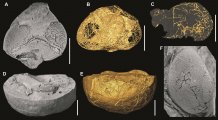Traces of substrate feeding inside shells of dead animals in the context of Great Ordovician Biodiversification Event
The study of several thousand Ordovician (i.e., early Palaeozoic) fossils, mostly trilobites, bivalves, gastropods and echinoderms, demonstrated that most carcasses have become a subject of systematic and sophisticated feeding since the Mid Ordovician. Feeding traces have been preserved as thin tunnels insubstrate inside shells of dead organisms. For a certain period, the substrate had been enriched by microbial consortia; firm fibrous tissues could function as the source of organic matter. Feeding patterns tend to recur for each fossil group; thereby, the positions and shapes of certain non-preserved tissues can be estimated. The above mentioned complex feeding strategies appeared around the GOBE (i.e., Great Ordovician Biodiversification Event) which occurred mainly from 465 to 460 Ma. Paper.


